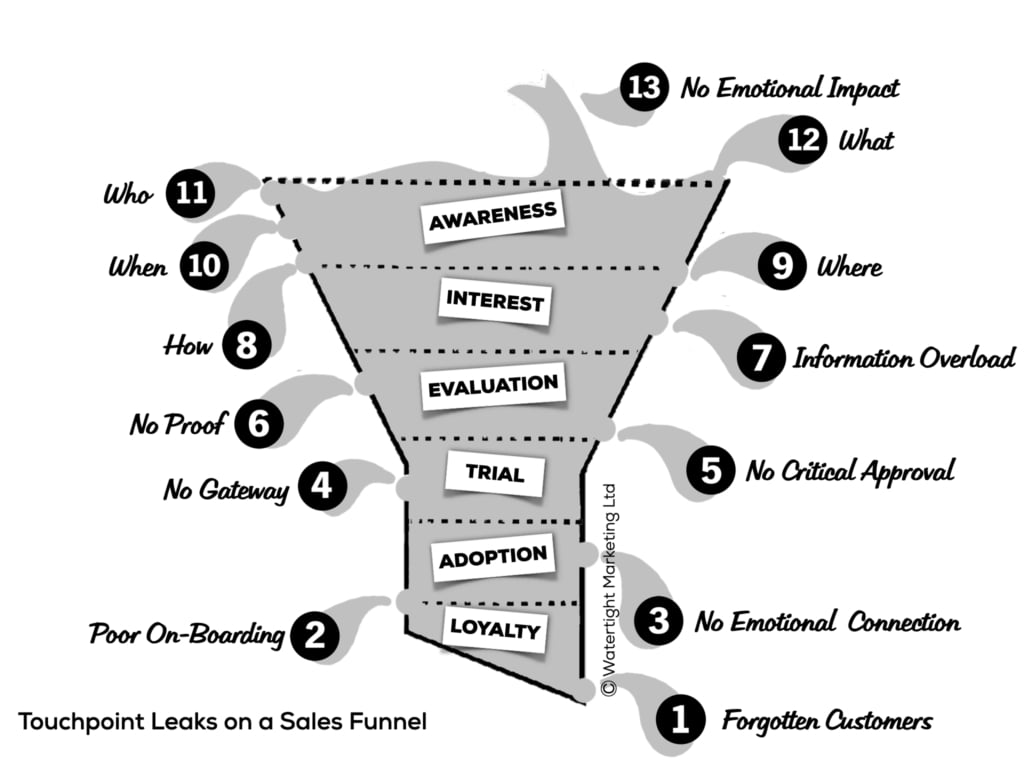Helsesjekk
Sales flow
Identify the most significant leaks in our sales funnel. Perspectives are designed based on the concept of Touchpoint Leaks in Watertight Marketing.

Identify the most significant leaks in our sales funnel. Perspectives are designed based on the concept of Touchpoint Leaks in Watertight Marketing.

When you do not stay appropriately in touch with customers, they are likely to forget about you. When it comes to buying again, or recommending to others, your name may not come to mind.
Do you have communications that mean existing and lapsed customers remember, repurchase and refer?
When there is limited personality or human touch in visuals and written style, or inconsistencies in experience across the organisation, trust is undermined, leading the potential customer to question whether or not to buy from you.
Do you have a consistent and compelling brand with which ideal customers really connect?
There is a critical time period between when a person has bought something, and when they consider themselves a loyal customer. This is the Welcome Window, and is your chance to make a lasting impression.
Do you have a structured set of communications that kicks in to warmly welcome new customers?
When the first purchase seems like a really big leap or potentially risky decision, people will delay or defer their decision to get started. This is where you need to create smaller stepping stones.
Can people experience what it would be like to be a customer before they are one?
Before spending a lot of money, or making a decision they consider risky, a buyer will often consult a third party, for example – a partner or colleague. In many cases, their approval is explicitly required. If that person says no to the purchase it will rarely proceed.
Do we have effective tools to reach anyone with the power of veto?
When weighing up alternatives for a purchase of considerable risk, people will look for evidence to back up claims that are being made. Where no proof can be found for the promises you make, the buyer is likely to look elsewhere.
Are we systematic in signposting proof for every promise that we make?
At the early stages of a sale, or simply when someone is curious about a topic but not ready to purchase, piling in with sales information, or deep knowledge and expertise, can be overwhelming and off-putting.
Do we have interesting information that invites people into finding out more?
Do we have interesting information that invites people into finding out more?
Is your material formatted in the ways preferred by those you wish to reach?
If you see the same information (or brand) represented in multiple places, or from sources you already trust, you are more likely to act on it. If you are not showing up where your potential buyers naturally look, you’re missing out.
Are you putting your materials where you know your ideal buyers are looking?
Not showing up, or being accessible, when the buyers are looking for the kind of things you sell. People will often research or browse information outside office hours, or in different time zones. If you are not there when they are looking, you’ve missed them.
At the early stages in a buying decision, people often ask for recommendations from people they loosely know, e.g. a peer in another division, an industry expert, a friend at the pub, in a Facebook status or Tweet. If your name isn’t thrown into the mix at this stage, you may not even be considered.
At the early stages in a buying decision, people often ask for recommendations from people they loosely know, e.g. a peer in another division, an industry expert, a friend at the pub, in a Facebook status or Tweet. If your name isn’t thrown into the mix at this stage, you may not even be considered.
Are you talked about by the people your ideal buyers listen to?
If you are not crystal clear and consistent in telling people what you do, and why you do it, people will contact you for things you don’t offer, or rule you out for things that you do. You may also attract customers you don’t enjoy, or can’t profit from, working with.
Are you clear and consistent in telling people what you do?
If the first thing people see from you doesn’t immediately grab their attention, and isn’t meaningful in relation to the emotional context of their lives, your marketing becomes wallpaper, and goes unnoticed.
Are the right people compelled to notice you?